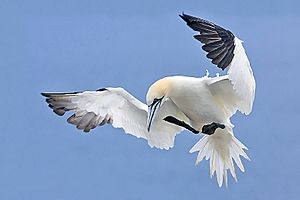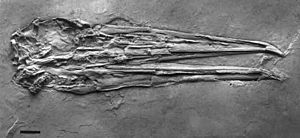Sulidae facts for kids
Quick facts for kids Sulidae |
|
|---|---|
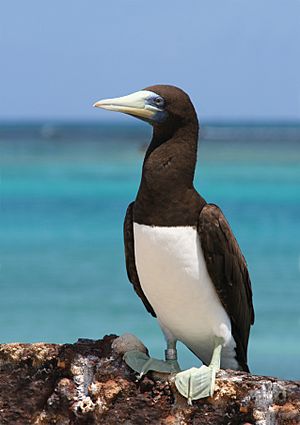 |
|
| Brown booby, Sula leucogaster | |
| Scientific classification |
|
| Kingdom: | Animalia |
| Phylum: | Chordata |
| Class: | Aves |
| Order: | Suliformes |
| Family: | Sulidae Reichenbach, 1849 |
| Genera | |
| Synonyms | |
|
Enkurosulidae Kashin, 1977 |
|
The Sulidae family includes amazing birds called gannets and boobies. These birds are often called sulids. They are medium to large seabirds that live near coasts. They hunt for fish and other small animals by diving headfirst into the water.
There are 10 different species in this family. In the past, all of them were sometimes grouped into one genus called Sula. But scientists can now easily tell the difference between Sula (the true boobies) and Morus (gannets). They look different, act differently, and even their DNA is different. Abbott's booby (Papasula) is so unique that it has its own genus. It seems to be a very old and separate group, possibly closer to gannets than to other boobies.
Contents
What Do Sulids Look Like?
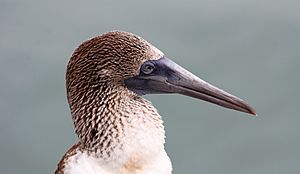
Sulids are usually about 60 to 85 centimeters (24 to 33 inches) long. Their wings can spread out from 140 to 175 centimeters (4.6 to 5.7 feet). They have long, thin, and pointed wings. Their tail is quite long and shaped a bit like a diamond, with the outer feathers being shorter.
Their bodies are very smooth and shaped like a "torpedo." This helps them cut through the water easily when they dive. Their flight muscles are small, which helps them be very streamlined for diving.
They have strong legs and webbed feet, meaning all four of their toes are connected by skin. For some species, these webbed feet are brightly colored. They use these bright colors in their courtship displays to attract a mate. Their bill (beak) is usually colorful, long, thick at the base, and pointed. It has saw-like edges to help them hold onto slippery fish. The top part of their bill curves down a little at the tip and can move upwards to grab big prey. To stop water from getting in when they dive, their nostrils open inside their bill, not directly outside. Their eyes face forward, giving them a wider view than most other birds.
Their feathers are either all white (or light brownish/greyish) with dark wingtips and tail, or dark brown/black on top with white underneath. Gannets often have a yellowish color on their heads. Their face usually has some black marks, especially around their eyes. Unlike their relatives, like darters and cormorants, sulids have a special gland that makes a waxy oil. They spread this oil on their feathers to make them waterproof and to keep away pests. They lose their tail feathers at different times and their wing feathers in stages. This means they always have some old, some new, and some growing feathers. They might also lose feathers if they are feeling stressed.
Where Do Sulids Live and What Do They Eat?
Sulids mostly live in warm tropical and subtropical waters. However, gannets can also be found in cooler temperate areas. These birds usually stay close to the coast. But many sulid colonies are found on Pacific islands. This suggests that storms can sometimes blow them far from home. If this happens, they can travel long distances to find a safe place to land.
All sulid species eat only at sea. They mostly eat medium-sized fish and other sea creatures like squid. Many species hunt together in groups. Some even follow fishing boats to eat discarded fish or bait. They typically hunt by diving from the air, going about 1 to 2 meters (3 to 6 feet) underwater. If the fish try to get away, the birds might chase them underwater using their legs and wings to swim.
Gannets and boobies have different behaviors, but all sulids share some common actions. Before they fly off, gannets point their bills upwards, while boobies point theirs forward. After they land, they point their bills downwards. If they feel threatened, they don't attack. Instead, they shake their heads and point their bills towards whatever is bothering them.
Reproduction and Life Cycle
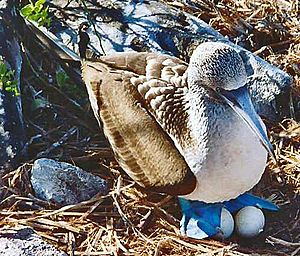
All sulids live and breed in large groups called colonies. First, the male birds fly around the colony area to find a good spot for a nest. They then defend this spot by fighting and showing off to other males. After that, males try to attract females with special displays and calls. Their displays are unique, often involving the male shaking his head. Females fly and walk around the colony looking for a mate. Once a female chooses a male, they stay together by preening (cleaning) each other's feathers.
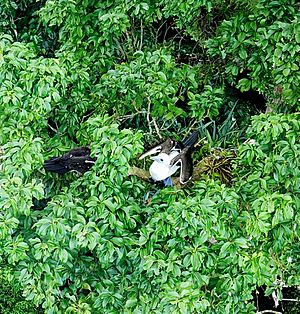
They usually lay two eggs. The eggs are plain (no spots or marks), and can be whitish, pale blue, green, or pink. They have a coating that looks like lime. The eggs weigh about 3.3% to 8.0% of the female's weight. The eggs hatch after 42 to 55 days, depending on the species. Both parents take turns keeping the eggs warm. They don't have a special patch on their belly for warming eggs. Instead, their feet get very warm with blood, and they place the eggs under their webbed feet. If they lose eggs during the first half of the incubation time, they will lay new ones.
When the chicks hatch, the parents move them to the top of their webbed feet. The young chicks are born without feathers, but soon grow soft white down feathers. They beg for food by touching the parent's bill and eat food that the parent brings up from its stomach. At first, at least one parent always stays with the young chicks. After two weeks, both parents might leave the nest sometimes to go fishing. How long it takes for the chicks to grow feathers and become independent depends a lot on how much food is available. Usually, only one chick survives to become an adult, except for the Peruvian booby (Sula variegata), which lays the most eggs (two to four). Sometimes, the stronger chick will kill its weaker sibling.
How Sulids Evolved
Sulids are related to other water birds that don't have outside nostrils and have all four toes webbed. Their closest living relatives are cormorants and darters. These three groups are part of a larger group called Sulae. Scientists think that Sulidae is the oldest and most unique group among these three.
In the past, sulids were thought to be part of the Pelecaniformes order, which includes pelicans. But scientists now know that pelicans are actually more closely related to herons and ibises. So, sulids and their relatives have been moved to a new order called Suliformes. This order also includes frigatebirds.
Within the Sulidae family, there are three main groups (genera) of living birds:
A study in 2011 looked at the genes of these birds. It found that Abbott's booby is the most ancient of all gannets and boobies. It likely separated from the others about 22 million years ago. The ancestors of gannets and the other boobies then split about 17 million years ago. All the different booby species we see today came from a common ancestor about 6 million years ago. Gannets split more recently, only about 2.5 million years ago.
| Species of Boobies and Gannets | ||
|---|---|---|
| Common and Scientific Names | Image | Where They Live |
| Northern gannet (Morus bassanus) |
 |
Western Europe and North America |
| Cape gannet (Morus capensis) |
 |
West to Southwest African coast |
| Australasian gannet (Morus serrator) |
 |
Australia and New Zealand |
| Abbott's booby (Papasula abbotti) |
 |
Christmas Island |
| Blue-footed booby (Sula nebouxii) |
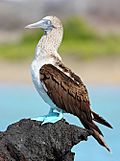 |
Eastern Pacific Ocean from California to the Galápagos Islands and south into Peru |
| Masked booby (Sula dactylatra) |
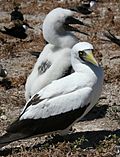 |
Tropical oceans around the world, between 30 degrees north and 30 degrees south. In the Indian Ocean, they are found from the Arabian Peninsula and East Africa to Sumatra and Western Australia. |
| Nazca booby (Sula granti) |
 |
Eastern Pacific from islands in Baja California to the Galápagos Islands, Isla de la Plata in Ecuador, and Malpelo in Colombia. |
| Brown booby (Sula leucogaster) |
 |
Tropical areas of the Atlantic and Pacific Oceans |
| Red-footed booby (Sula sula) |
 |
Most tropical ocean areas, except parts of the eastern Atlantic and southeastern Pacific. They breed on islands. |
| Peruvian booby (Sula variegata) |
 |
Coast of South America from Peru to Chile |
Scientists have found many fossils of sulids, especially from the Miocene and Pliocene periods. The oldest sulid fossils go back to the Eocene period. It seems that sulids separated from the group that includes cormorants and darters about 50 million years ago. Early sulids included some strange extinct types, like Masillastega (which might not have been a modern sulid) or Rhamphastosula (which had a bill shaped like a toucan's relative). The modern groups of sulids started to appear around 23 million years ago. Microsula, an ancient booby from that time, still had many features similar to gannets. Like other birds in their group, sulids probably first appeared in the Atlantic or western Tethys Sea area. This is because their oldest fossils are common in Europe but not in similar age rocks in America.
Images for kids
See also
 In Spanish: Súlidos para niños
In Spanish: Súlidos para niños


